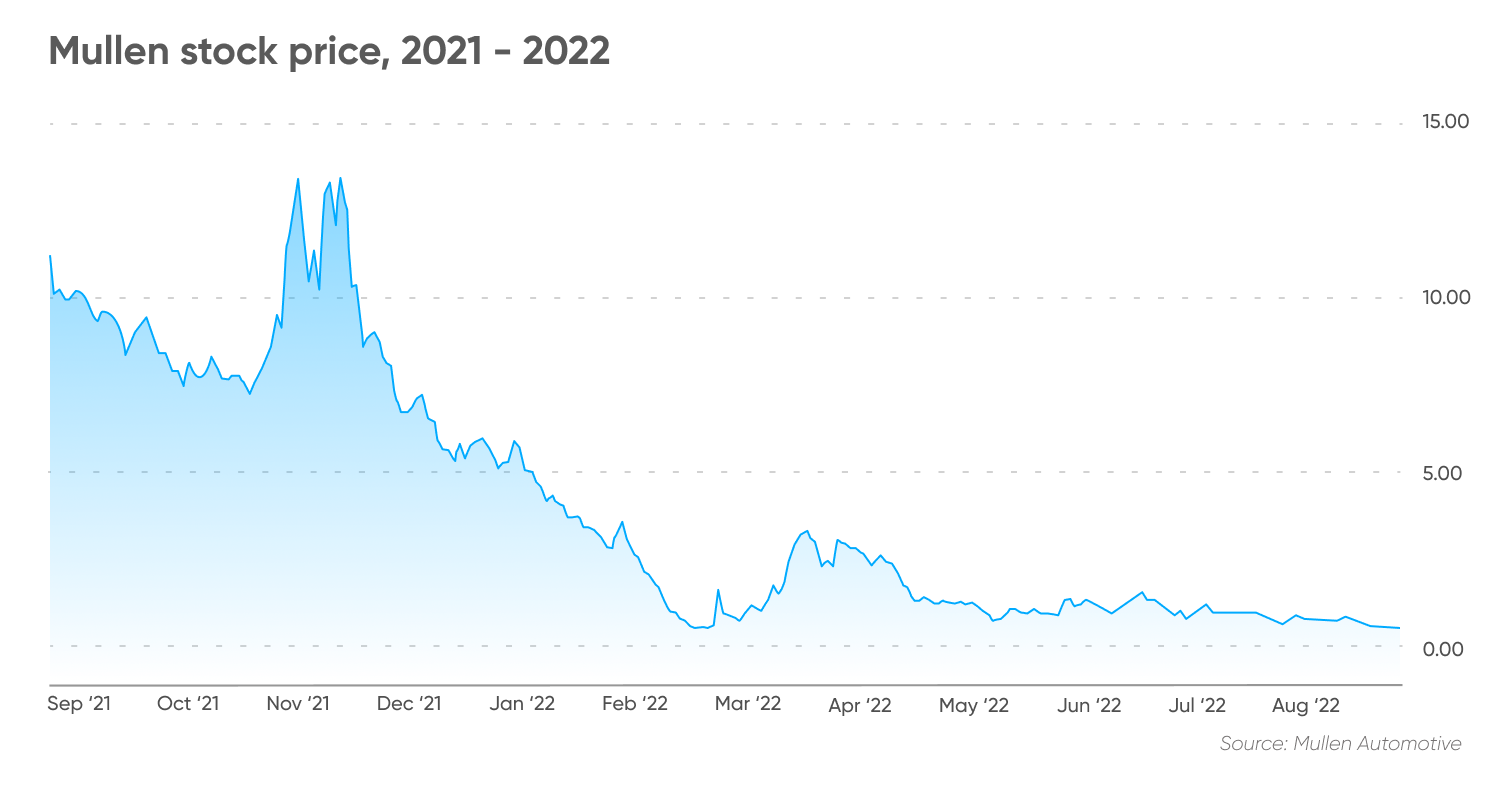Mullen Automotive stock forecast: Will its first dealer partner deal lift the stock?
A partnership with RMA could provide MULN with a much-needed boost
The stock price of US electric vehicle (EV) maker Mullen Automotive (MULN) has continued to fall since its debut in 2021.
Over the course of 2022, MULN shares have remained below $1. Although energy transition move brighten prospects for a boost in EV demand. But, tailwinds, such as the company’s inclusion in the Russell 2000 (RTY) and Russell 3000 indices, have failed to cushion the fall.
In mid-December 2022, Mullen announced it had picked Randy Marion Automotive Group as its first US dealer partner for the company’s commercial EV lineup.
Will the partnership with one of the largest commercial auto dealer groups in the US help the Mullen Automotive stock price recover from the slump?
In this article we take a look at the latest Mullen Automotive stock news and other factors that may shape a Mullen Automotive stock forecast.
What is Mullen Automotive?
Headquartered in Southern California, Mullen Automotive (MULN) manufactures and distributes EVs.
The company was founded in 2014 as Mullen Technologies, the result of a merger between CODA Automotive and Mullen Motor Cars. CODA was a manufacturer of all-electric sedans, and for a time was one of the only two certified companies selling EVs in the US – the other being Elon Musk’s Tesla (TSLA).
The firm became Mullen Automotive in November 2021, following a reverse merger with Net Element. As a result, Mullen Automotive became a public company, officially debuting on the Nasdaq stock exchange in November 2021 under the ticker symbol MULN.
The company’s main product is the all-electric sport utility vehicle (SUV) Mullen Five EV Crossover, which was released on 17 November 2021. It is in the process of launching the all-electric sports car, DragonFly. In addition, the company plans to design, customise and manufacture multi classes of commercial electric cargo vans at its Tunica plant.
Mullen is also developing a 150 kilowatt-hour solid-state polymer battery cell that it hopes will power its Mullen Five EV. If the battery proves to be successful, the vehicle will be able to travel more than 600 miles on only one fully charged battery.
Mullen Automotive stock analysis & historical performance
Since its Nasdaq debut in November 2021 as the surviving post-merger company with Net Element (NETE), the MULN stock value has been in decline. Soaring fuel prices since last year, which raised the prospect of higher demand for EVs, have done little to stem the drop in MULN’s stock price.
At the time of writing (30 December), Mullen Automotive stock has fallen nearly 95% on a year-to-date (YTD) basis to $0.28, from $5.8 at the beginning of January 2022, according to Trading View data. Mullen automotive stock price has traded at about 97.8% below the value when it debuted in 2021 at $12.99.
In comparison, the Russell 2000 (RTY) index has fallen 21.39% over the same period. Mullen’s rival Tesla (TSLA) has seen its stock drop 68.16% YTD.

Mullen Automotive reduces debt
Mullen Automotive reported $99m worth of cash or cash equivalents on its balance sheet, according to the company’s preliminary third-quarter results published on 8 August.
According to the report, the company’s total assets grew 391%, primarily driven by cash from financing activities along with increased property and equipment.
It reported positive working capital of $27.66m and financial commitments of $318m, positioning the company for growth in 2022 and 2023.
The company also managed to further reduce its debt. In November, the company announced that it had eliminated $13m of debt associated with an obligation to Esousa Holdings, LLC. The latest debt payment lowered its outstanding obligations to less than $10m, from over $30m in 2021.
Ground-breaking deal with Randy Marion
Despite a slew of positive news, such as successful test results by Indiana’s Battery Innovation Center (BIC) on Mullen’s solid-state battery and the stock’s inclusion on Russell indices, the Mullen Automotive stock price hasn’t shown any signs of recovery.
The passing of the Inflation Reduction Act by the US Senate on 7 August, which could be a tailwind that EV manufacturers need, did not improve sentiment on the Mullen Automotive stock price.
According to the “Summary of the Energy Security and Climate Change Investments in the Inflation Reduction Act of 2022”, the bill provides incentives that may benefit EV producers like Mullen Automotive. The incentives include a $10bn investment tax credit to build clean technology manufacturing facilities, including for the production of EV, wind turbines and solar panels.
It also offers up to $20bn loans to build new, clean vehicle manufacturing facilities.
In recent Mullen Automotive stock news, the company announced it picked Randy Marion Automotive Group (RMA) as its first dealer group partner for Mullen’s commercial EV lineup.
The company commercial EV lineup includes Class 1-3 cargo van and cab chassis offerings and Bollinger Motors Class 4-6 chassis products, which are set to be launched in 2023.
Following the partnership deal, on 14 December, Mullen announced that it had received a purchase order for 6,000 Class 1 EV cargo vans from Randy Marion Isuzu, LLC, a member of RMA. The order is valued at approximately $200m and the first delivery is expected in the first quarter of 2023.
The deal with RMA topped previous Mullen EV purchase deals. In July, Mullen announced an agreement with DelPack Logistics, an Amazon Delivery Services Partner, to purchase up to 600 Mullen Class 1 and 2 EV cargo vans over the next 18 months.
Mullen Automotive stock forecast: 2022-2025 target
Will the agreement with Randy Marion raise Mullen Automotive stock forecast?
Algorithm-based forecasting service Wallet Investor was bearish in its Mullen Automotive stock predictions, noting that the stock was a bad long-term investment.
The service’s Mullen Automotive stock forecast for 2023 projected that the stocks would remain below $1 per share. Wallet Investor’s Mullen Automotive stock forecast 2025 saw the stock to trade at $0.000001 in December 2025.
Panda Forecast’s Mullen Automotive share price forecast was rather bullish. As of 30 December, the service’s minimum MULN stock price target was average $23 in 2025.
When looking for MULN stock projections, keep in mind that analysts and algorithm-based forecasts can be wrong. Mullen Automotive stock predictions over the period will be influenced by a variety of factors, including Mullen’s rate of development and overall economic factors such as increasing costs of living.
MULN stock forecasts shouldn’t be used as a substitute for your own research. It is critical to conduct your own due diligence before trading, looking at the latest news, technical and fundamental analysis, and analysts’ commentary.
Note that past performance does not guarantee future returns and never trade money that you cannot afford to lose.
FAQs
Is Mullen Automotive a good stock to buy?
Whether or not Mullen Automotive stock is a good investment for you will depend on the composition of your portfolio, your investment goals and your risk tolerance. You should always conduct your own research. Never invest money that you cannot afford to lose.
Will Mullen Automotive stock go up or down?
As of 30 December, Wallet Investor expected Mullen Automotive’s stock to go down to $0.000001 by December 2023, and remain at that level until 2027.
Panda Forecast predicted the stock to trade at minimum average of $23 in 2025.
Remember that forecasts can be wrong and have been inaccurate in the past. Always do your own research. Never trade money that you cannot afford to lose.
Should I invest in Mullen Automotive stock?
Your decision to invest in Mullen Automotive (MULN) should be based on your risk tolerance, investment objectives, portfolio composition and experience in the markets. You should do your own research. Never trade money that you cannot afford to lose.